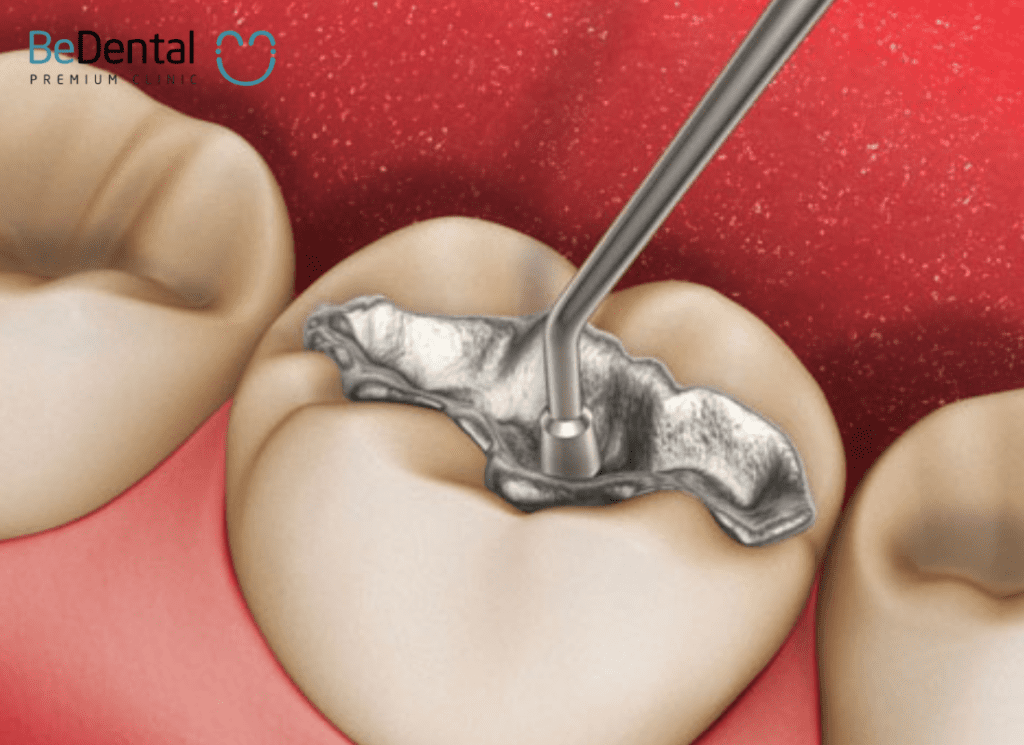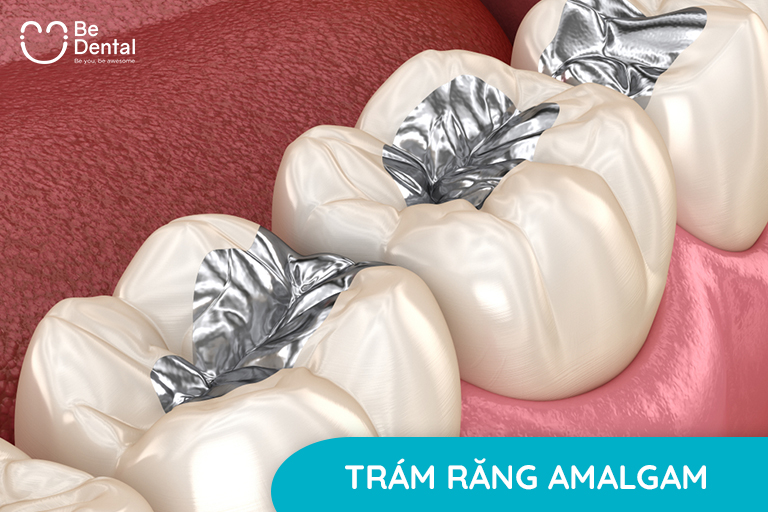5 Most Common GIC Tooth Fillings Nowadays. GIC tooth filling is a method used to address dental imperfections such as cavities and chipped teeth without altering the structure of the tooth. It is widely used nowadays. Let’s find out through the following article from BeDental dental clinic.
Why do we need tooth fillings?

Preventing tooth loss
Teeth can be difficult to treat and may need to be extracted if prolonged pulpitis leads to tooth abscess and tooth mobility. The reason is that bacteria have invaded the pulp due to tooth fractures or cavities. Therefore, tooth fillings can help prevent deep bacterial invasion into the tooth.
Contributing to the treatment of dental diseases
Cavities can be highly damaging if left untreated. One of the consequences is that bacteria can destroy tooth enamel and dentin, eventually leading to tooth loss. However, if the disease is left untreated for too long, it can be challenging to completely treat.
Ensuring proper chewing function
Tooth fillings help maintain the natural chewing function of the tooth by filling in the empty spaces caused by tooth loss. This helps prevent food from getting stuck in the decayed tooth, which can cause tooth decay and make oral hygiene difficult.
Enhancing aesthetics at an affordable cost
Tooth fillings also contribute to the restoration of the tooth’s aesthetics. This method is easy to perform and has a relatively low cost compared to dental veneers. Additionally, tooth fillings are made of materials that closely resemble the natural tooth color, making this method widely used and popular.
Do dental crowns require anesthesia? The process of getting dental crowns with anesthesia
Who should consider getting tooth fillings?

Chipped tooth
Teeth can be chipped due to chewing, biting hard objects or foods, or weakened tooth structure. If the chip is moderate and detected early, it can be repaired by filling the chipped or fractured tooth with materials such as GIC or other filling materials.
During the filling process, dentists will clean the oral cavity to remove bacteria, then apply the chosen filling material to the chipped area of the tooth, restoring it to its natural appearance.
Diastema (gapped teeth)
Our facial aesthetics can be significantly affected if we have gaps between our teeth. To address this issue, many people choose to undergo tooth filling for diastema. This method can be used for cases where the gap is less than 2mm. For larger gaps, the dentist will assess the condition and choose a more suitable treatment approach.
Replacing old fillings
After a certain period of time, tooth fillings can become loose, cracked, or worn out due to eating hard foods or simply due to the passage of time. Although tooth fillings are a simple and cost-effective method, they are not permanent.
Therefore, if you notice any signs of damaged fillings as mentioned above, you should visit a dental clinic to have them replaced and restore the tooth to its original condition.
What is an implant-supported removable denture? Is it truly worth using?
The 5 most common GIC tooth fillings nowadays

Gold filling
The gold filling method uses materials made of gold alloy and is usually chosen for filling molars due to their high hardness and durability.
The advantage of gold fillings is that they can withstand normal chewing forces like natural teeth, and the filling can last for 10-15 years. However, the cost of this material is higher compared to GIC tooth filling or other materials.
Additionally, the filling process takes more time, and the color will be noticeably different from natural teeth, so it is recommended to only fill teeth in hidden areas to maintain aesthetic appearance when speaking or smiling.
Dental porcelain filling
For larger, aesthetically demanding tooth fractures, dental porcelain (also known as onlays and inlays) is commonly used as a filling material.
The reason for using porcelain in areas that require more coverage is because it is a durable material that can withstand chewing forces well. Additionally, with the use of CAD/CAM technology, porcelain fillings do not change color like composite materials, ensuring long-term aesthetics and making daily oral hygiene easier.
However, similar to gold fillings, porcelain fillings are expensive, and the filling process requires more techniques and time.
Composite filling
Filling teeth with composite material is a popular method due to its simple and quick implementation and reasonable cost.
Composite has a color that matches the natural teeth, so it is often used in areas that require high aesthetics. Compared to dental porcelain fillings, composite fillings are more affordable, but they are prone to wear over time.
In addition, compared to other materials, the durability of composite is not high, and it can deform over time or when subjected to strong forces. This material is not recommended if you consume substances such as tea, coffee, or tobacco, as it can absorb saliva and coloring agents, causing discoloration and compromising aesthetics.
What is Amalgam Dental Filling? 4 Advantages of Amalgam Dental Filling
Amalgam

Another name for Amalgam filling is silver filling, a material made from a combination of copper, mercury, tin, and silver. Amalgam material has a silver color, different from the color of natural teeth, so it is used to fill molars or premolars.
Compared to composite, the cost of Amalgam filling is lower, but on the other hand, it has a longer lifespan, better durability, and resistance. However, the aesthetic aspect of this material is not high due to its gray color, which is far from the color of natural teeth.
Additionally, the filling can easily chip and fragments can fall off when chewing. Therefore, after 24 hours of filling, patients should limit chewing food and wait for the filling to become more solid.
If you are pregnant, it is not recommended to use Amalgam for tooth filling as it contains mercury, which can cause irritation and toxicity. Being a metal, it is also sensitive to changes in temperature after filling.
GIC
GIC, also known as glass ionomer cement, is commonly used for teeth that do not undergo strong chewing forces. This material was developed after Amalgam and has some special advantages. Let’s learn more about this material through the following sections.
The effects of Glass Ionomer Cement dental material
Glass Ionomer Cement (GIC) is a cosmetic filling material that is a white powder produced in 1972 as a replacement for silicate. Nowadays, GIC is increasingly improved in terms of transparency, chemical properties, mechanical properties, and compatibility with resin to enhance adhesion to tooth enamel, increase strength, and abrasion resistance.
This material is suitable for filling both deciduous and permanent teeth, with the function of restoring tooth cusps, restoring the original shape of the tooth, and lining the filling.
What is GIC tooth filling?
GIC tooth filling is a cosmetic tooth filling method that uses GIC as the filling material. GIC material in the filling process is made into an artificial tooth enamel to fill deep cavities, broken teeth after grinding, clean and disinfect the oral cavity.
Due to the high aesthetic aspect of GIC tooth filling, it is often used to fill visible positions such as front teeth. GIC tooth filling has a relatively low cost, and the filling process does not take much time, so it is widely applied.

Similar to gold, dental porcelain, or composite tooth fillings, GIC tooth filling also has its own unique advantages and disadvantages.
Advantages:
- Compared to Amalgam tooth filling, GIC tooth filling has higher aesthetic value, although not as high as composite.
- Due to the white powder color of GIC material, it is difficult to detect the filling when it matches the color of the tooth.
- Especially when filling deep cavities, GIC tooth filling can prevent bacterial infiltration as the mixture contains fluoride.
- Relatively low cost and quick filling time.
Disadvantages:
- In terms of durability, GIC tooth filling is not as strong as Amalgam.
- Although it has a color similar to the tooth, in terms of complete compatibility, composite seems to have an advantage. Therefore, when choosing, you should consider between these two materials.
- In terms of strength and erosion resistance, this method is not really good. Therefore, GIC tooth filling is usually used for teeth with less chewing force, such as premolars, rather than molars.
How to Stop Bleeding after Wisdom Tooth Extraction? Some Ways to Control Bleeding
Should you get GIC tooth filling or not?

It can be said that in terms of popularity, GIC tooth filling is not as common as composite. Part of the reason is that the durability of this material is not high compared to other materials, so it is usually only used for filling baby teeth in children, premolars, etc., and not for filling molars or teeth that undergo strong chewing forces.
As for deep cavities in adults, GIC is used to fill the base layer first, and then composite or Amalgam is placed on top. Once completely filled with GIC, it should only be applied for a short temporary period and should be replaced with other filling materials to ensure longer durability.
Depending on the purpose and location of the tooth that needs filling, GIC tooth filling method can be used or replaced with other materials. However, GIC tooth filling is still considered a safe, low-cost, and quick method of tooth filling. Therefore, it is advisable to consult with a dentist to choose the most suitable tooth filling method.
GIC tooth filling procedure at BeDental dental clinic.

When performing GIC tooth filling at BeDental dental clinic, you will undergo a thorough examination before proceeding with the filling in 4 steps. Specifically:
Step 1: Consultation with the dentist
Examination is a very important step before any dental procedure, not just GIC tooth filling. The dentist will check the current condition of your oral health and determine the location that needs filling, the reasons for filling, the size of the filling, and the appropriate filling material to be used.
After the examination, the dentist will provide guidance on the filling procedure and help the patient choose a material that fits within their budget. Once the patient fully understands and agrees, the filling process can begin.
Step 2: Anesthesia and cleaning of the filling area
If the tooth has deep decay, the dentist will use specialized tools to remove the damaged area. During the filling process, to prevent pain and ensure patient comfort, the dentist will administer local anesthesia around the filling area. If there is tartar present, the dentist will also perform scaling to ensure that there is no infection after the filling.
Step 3: GIC tooth filling
After cleaning and anesthesia, the tooth filling will be performed. The GIC material will be placed in the cleaned area by the dentist.
Step 4: Finishing, adjusting, and restoring the original shape of the tooth
Finally, the dentist will remove any excess filling material and adjust the filling. The goal is to make the filling closely resemble the natural tooth, achieve the highest aesthetic result, and prevent any discomfort caused by overfilling. At this stage, the filling will also be polished and smoothed to resemble a natural tooth.
Cost of GIC tooth filling
Currently, there are many dental clinics that offer GIC tooth filling, which means that there are different price ranges. However, the cost of GIC tooth filling generally ranges from 100,000 to 200,000 VND (excluding root canal treatment).
Compared to the cost of composite tooth filling, this is a reasonable price. Note: It is not advisable to choose a dental clinic with extremely low prices, as the origin of the filling material may not be guaranteed or the dental team may not have sufficient expertise, which can lead to complications.
Some considerations when filling teeth with GIC
When filling teeth with GIC, it is important to note the following:
- Clean your teeth 30 minutes after eating to remove any leftover food debris.
- In addition to brushing your teeth with toothpaste, use saltwater or mouthwash to achieve better oral hygiene.
- Avoid consuming food that is too hot or too cold.
- Avoid eating hard foods or applying excessive force to the filling area to prevent the filling from cracking or breaking.
- Avoid substances that can cause teeth staining, such as coffee, tobacco, tea, etc.
- Minimize excessive chewing force on the filling area.
- If you experience pain or discomfort after the filling, contact your dentist for a follow-up appointment and do not self-medicate with pain relievers.
- Follow the instructions given by the dentist.
BeDental – a reliable and quality dental clinic for GIC tooth filling.

BeDental dental clinic is confident in being a reputable dental care provider for patients’ oral health. When you come to get GIC tooth filling at BeDental, you will undergo a thorough examination and receive dedicated advice on the current condition of your oral health in order to choose the appropriate filling material.
In particular, the clinic will provide information on the prices of each material to the patients during the consultation process so that they can feel assured about the cost of the filling. After the filling process, the dentists will provide instructions on how to protect and maintain the filling, ensuring the quality of the GIC tooth filling for the patients.
Tư vấn chuyên môn bài viết:
BÁC SĨ ĐÀM TRỌNG HIẾU
BEDENTAL - TOP STANDARD DENTISTRY SYSTEM
In HANOI
Address 1: 7B Thi Sach St, Ngo Thi Nham, Hai Ba Trung Dist, Ha Noi. - 0934.61.9090
Address 2: No 129 Hoang Ngan, Yen Hoa, Cau Giay Dist, Ha Noi. - 0934.61.9090
In HO CHI MINH
Address 1: 53 -55 -57 Pho Duc Chinh St, Nguyen Thai Binh, Dist. 1, Ho Chi Minh. - 0766.00.8080
Working: 9am - 8pm everyday
Website: https://bedental.vn/en/
Please leave your contact information if you would like further dental advice.





